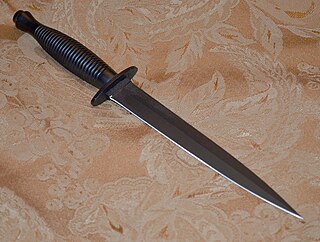
A dagger is a fighting knife with a very sharp point and usually two sharp edges, typically designed or capable of being used as a thrusting or stabbing weapon. Daggers have been used throughout human history for close combat confrontations, and many cultures have used adorned daggers in ritual and ceremonial contexts. The distinctive shape and historic usage of the dagger have made it iconic and symbolic. A dagger in the modern sense is a weapon designed for close-proximity combat or self-defense; due to its use in historic weapon assemblages, it has associations with assassination and murders. Double-edged knives, however, play different sorts of roles in different social contexts.

A knife is a tool or weapon with a cutting edge or blade, usually attached to a handle or hilt. One of the earliest tools used by humanity, knives appeared at least 2.5 million years ago, as evidenced by the Oldowan tools. Originally made of wood, bone, and stone, over the centuries, in step with improvements in both metallurgy and manufacturing, knife blades have been made from copper, bronze, iron, steel, ceramic, and titanium. Most modern knives have either fixed or folding blades; blade patterns and styles vary by maker and country of origin.
A spear is a pole weapon consisting of a shaft, usually of wood, with a pointed head. The head may be simply the sharpened end of the shaft itself, as is the case with fire hardened spears, or it may be made of a more durable material fastened to the shaft, such as bone, flint, obsidian, iron, steel, or bronze. The most common design for hunting or combat spears since ancient times has incorporated a metal spearhead shaped like a triangle, lozenge, or leaf. The heads of fishing spears usually feature barbs or serrated edges.

A bayonet is a knife, dagger, sword, or spike-shaped weapon designed to fit on the end of the muzzle of a rifle, musket or similar firearm, allowing it to be used as a spear-like weapon. From the 17th century to World War I, it was a weapon for infantry attacks. Today it is considered an ancillary weapon or a weapon of last resort, although it is still used for ceremonial purposes.

A shuriken is a Japanese concealed weapon that was used as a hidden dagger or metsubushi to distract or misdirect.

A blade is the portion of a tool, weapon, or machine with an edge that is designed to puncture, chop, slice or scrape surfaces or materials. Blades are typically made from materials that are harder than those they are to be used on. Historically, humans have made blades from flaking stones such as flint or obsidian, and from various metal such as copper, bronze and iron. Modern blades are often made of steel or ceramic. Blades are one of humanity's oldest tools, and continue to be used for combat, food preparation, and other purposes.

A Bowie knife is a pattern of fixed-blade fighting knife created by Rezin Bowie in the early 19th century for his brother Jim Bowie, who had become famous for his use of a large knife at a duel known as the Sandbar Fight.

A tomahawk is a type of single-handed axe used by the many Indigenous peoples and nations of North America. It traditionally resembles a hatchet with a straight shaft. In pre-colonial times the head was made of stone, bone, or antler, and European settlers later introduced heads of iron and steel. The term came into the English language in the 17th century as an adaptation of the Powhatan word.

In modern terminology, the Arkansas toothpick is a heavy dagger with a 12-to-20-inch pointed, straight blade. The knife can be used for thrusting and slashing. James Black, known for improving the Bowie knife, is credited with inventing the Arkansas toothpick.
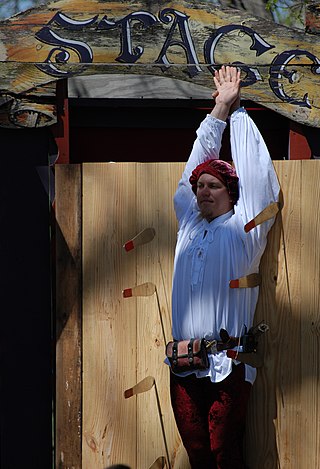
Knife throwing is an art, sport, combat skill, or variously an entertainment technique, involving an artist skilled in the art of throwing knives, the weapons thrown, and a target. In some stage performances, the knife thrower ties an assistant to the target and throws to miss them.

A throwing knife is a knife that is specially designed and weighted so that it can be thrown effectively. They are a distinct category from ordinary knives.
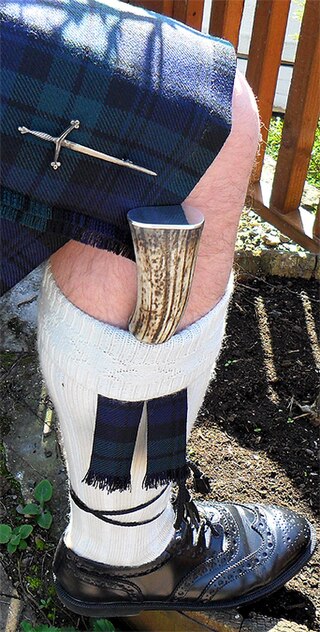
The sgian-dubh – also anglicized as skene – is a small, single-edged knife worn as part of traditional Scottish Highland dress along with the kilt. Originally used for eating and preparing fruit, meat, and cutting bread and cheese, as well as serving for other more general day-to-day uses such as cutting material and protection, it is now worn as part of traditional Scottish dress tucked into the top of the kilt hose with only the upper portion of the hilt visible. The sgian-dubh is normally worn on the same side as the dominant hand.
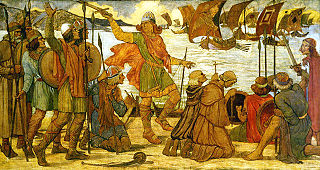
Knowledge about military technology of the Viking Age is based on relatively sparse archaeological finds, pictorial representation, and to some extent on the accounts in the Norse sagas and laws recorded in the 14th century.
A stiletto is a knife or dagger with a long slender blade and needle-like point, primarily intended as a stabbing weapon.

A ballistic knife is a knife with a detachable blade that can be ejected to a distance of several meters/yards by pressing a trigger or operating a lever or switch on the handle. Spring-powered ballistic knives first appeared in books and press reports on Soviet and Eastern Bloc armed forces in the late 1970s. Commercially-produced ballistic knives briefly gained notoriety in the United States in the mid-1980s after they were marketed and sold in the United States and other Western countries. Since then, the marketing and sale of ballistic knives to civilians has been restricted or prohibited by law in several nations.

A pistol sword is a sword with a pistol or revolver attached, usually alongside the blade. It differs from a rifle with a bayonet in that the weapon is designed primarily for use as a sword, and the firearm component is typically considered a secondary weapon designed to be an addition to the blade, rather than the sword being a secondary addition to the pistol. In addition, the two components of these weapons typically cannot be separated, unlike most bayonet-fixed rifles.

A push dagger is a short-bladed dagger with a "T" handle designed to be grasped and held in closed-fist hand, so that the blade protrudes from the front of the fist, either between the index and middle fingers, or between the two central fingers, when the grip and blade are symmetrical. Less often also called a push dirk.
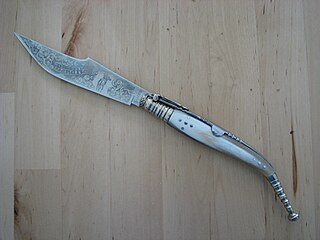
The navaja is a traditional Spanish folding-blade fighting and utility knife.

Jujutsu, also known as jiu-jitsu and ju-jitsu, is a family of Japanese martial arts and a system of close combat that can be used in a defensive or offensive manner to kill or subdue one or more weaponless or armed and armored opponents. Jiu-jitsu dates back to the 1530s and was coined by Hisamori Tenenouchi when he officially established the first jiu-jitsu school in Japan. This form of martial arts uses few or no weapons at all and includes strikes, throws, holds, and paralyzing attacks against the enemy. Jujutsu developed from the warrior class around the 17th century in Japan. It was designed to supplement the swordsmanship of a warrior during combat. A subset of techniques from certain styles of jujutsu were used to develop many modern martial arts and combat sports, such as judo, aikido, sambo, ARB, Brazilian jiu-jitsu, and mixed martial arts. The official date of foundation of Jiu Jitsu is 1530.
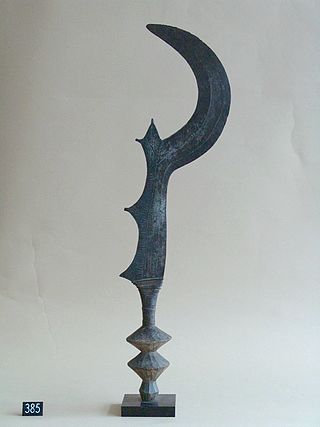
A Ngulu is an execution sword used by the Bantu peoples of the Congo Basin.


















